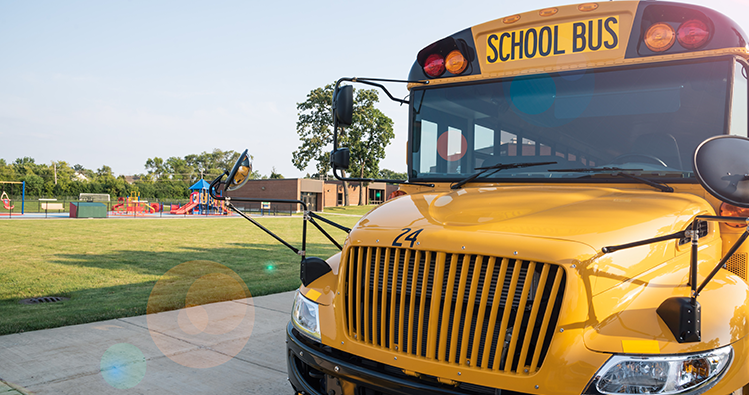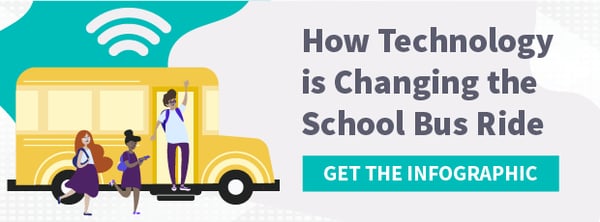
Even a 39-minute bus ride – the average bus ride time according to a recent Kajeet survey – requires more than a physical bus, the driver, and students. Today’s school bus fleets have expanded to include technology as we drive into 2020.
According to the “Miles to Go: Bringing School Transportation into the 21st Century” 2017 report by Bellweather Education Partners, “One of the largest issues affecting the operational efficiency of student transportation is what can best be described as a ‘data deficit.'” The authors of this report recommend investing in tools and technologies to help improve operational efficiency and improve the ridership experience.
So, if you’re sitting here and wondering what technology is available for school buses (and why), keep reading.
Push-to-Talk Radios
Currently, 83 percent of K-12 transportation professionals currently have driver radio communication on their buses. This could include Land Mobile Radio or the more advanced, LTE-enabled push to talk radios.
What is push-to-talk or PTT? PTT provides instant communication between school bus operation teams, from one-to-one communication, or one-to-many. A routing supervisor could communicate with a bus driver specifically to alert him or her of a route change, or a transportation director could communicate with all of their bus drivers at once to notify them of a change.
Combining PTT radios with a dispatch console software provides a multi-channel, full feature dashboard to manage all radio users. The Transportation Director or Supervisors typically have access and can view the radio (and therefore, their drivers’) locations, embed recordings, and send out mass communications.
Camera Data Offload
Next up, we have camera data offload. What is video camera data offload, and why is it important?
Let’s explore.
Cameras are ranked as the #1 most important technology on the school bus, with 87 percent of survey respondents who currently have cameras on their school buses, either inside, outside, or stop-arm cameras. Some transportation departments have as many as ten cameras on one bus! That’s a lot of video data.
If you have school bus camera systems in place with your fleet, you could be wasting hours of your time (or your employees) physically collecting the SD card or hard drive from every single bus.
Enter, the Kajeet SmartBus Offload bundle that provides everything you need to automatically offload your data from school bus video systems. You can request to learn more about camera offload here.
With the bundle, you will receive:
- Ethernet cable for camera DVR and Kajeet router
- Automatic camera data download to your school or district’s server
- Access to the Kajeet Sentinel® cloud portal
- LTE data
To recap, if you’re part of that 87 percent with cameras, or one day hope to join that group, camera data offload is the next piece of your bus technology puzzle.
GPS: Not All Location Trackers are Created Equal
GPS is the broadest of all the bus technology terms. If you ask what GPS is, you’ll hear the main definition as Global Positioning System, which is where the acronym originates.
Over half (56 percent) of survey respondents said they currently have GPS on their school buses. But GPS has different tiers to it and is often included in most of the bus technology you see today.

At a more basic level, GPS tracks the current location of every single bus. From there, this technology can also keep track of historical location, providing transportation departments insight into the routes their drivers took that day.
Breadcrumb trail reports provide an easy visual on a map of where your buses were driving. This visual can help point out any discrepancies along with potential route optimization options.
More enhanced GPS can also communicate out to parents, which leads us to parent notifications.
School Bus Parent Notifications and Student Ridership
As technology advances in schools and on the school buses, parents start to expect a level of insight that they couldn’t have before. You might be wondering, “How do I notify parents of their student’s locations?”
Well, if you have GPS on your school bus, you can combine that with a parent notification app to keep parents in-the-know.
How does it work?
Some parent notification apps alert the parent to when their child’s bus is near the bus stop, and once it is near and has arrived at their child’s school. Other parent notification apps provide more specifics on their student, including ridership.
What is student ridership?
Student ridership and parent notifications often go hand-in-hand. Students can board the bus with an ID card or a fob for the following reasons:
- Bus drivers can confirm that the child is on the right bus
- As students arrive on the bus, their parent can be notified that their child’s ride has started and that bus’s location
- Bus drivers can also confirm that the child got off at the right stop
WiFi for School Buses
Lastly, we will go over WiFi for school buses. What is school bus WiFi exactly and how does it work?
Adding WiFi to school buses is often the connecting component for all the aforementioned technology. While most bus technology comes with its own data plan, school buses with WiFi already can see savings by only going to one source for the data they need.
School buses with WiFi can do more than just connect technology; it can:
- Provide students an additional opportunity to work on their homework, keeping students focused, and therefore quieter
- Due to quieter students, school buses with WiFi often seen a reduction in behavior incidents
- Close the Digital Divide for students that do not have Internet access at home and are therefore unable to get their homework done the same as their more affluent peers
Adding more technology to the school bus is a major trend for 2020. But adding technology with purpose is key. As that Bellweather report stated, transportation departments lack data to help improve operational efficiency. This technology can all be beneficial, but make sure you have a way to track progress either through a dashboard or your own metrics.


